What kind of shoes for an 18 month old? Eighteen months is a busy time! Your little one is likely on the move, exploring their world with newfound independence. Proper footwear is important for their healthy development. This article will explore different shoe types suitable for 18-month-olds, focusing on comfort, support, and flexibility.
Understanding Your Toddler’s Needs
- Rapid Growth: Toddlers’ feet grow quickly at this age. Shoes should have some room for growth, but not so much that they flop around.
- Building Strength: The right shoes will allow for flexibility and proper movement, which is crucial for developing strong muscles and coordination.
Walking Style
- Newfound Confidence: Eighteen-month-olds are typically confident walkers, but they may still wobble a bit. Stability and good traction are important.
Choosing the Right Shoes for Your Toddler
Look for These Features:
- Supportive: The shoes should have a firm but flexible sole that bends easily at the toes. This allows for natural foot movement while providing some support.
- Good Fit: Well-fitting shoes are essential for comfort and safety. They should be snug but not tight, with enough wiggle room for toes.
- Breathable Materials: Look for shoes made from breathable materials like leather or mesh to keep your toddler’s feet cool and comfortable.
- Easy On and Off: Shoes with velcro closures or elastic laces are ideal for toddlers who are still learning to put on their own shoes.
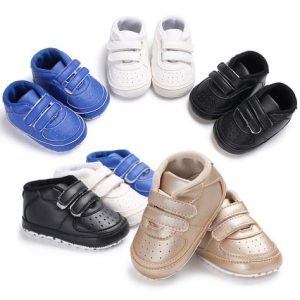
Types of Shoes for 18-Month-Olds
Consider these options:
- Sneakers: A good all-around choice for active toddlers. Look for sneakers with a flexible sole and good traction.
- Boots: Booties can be a good option for colder weather or for toddlers who need extra ankle support. Choose boots with a flexible sole and avoid anything too heavy or bulky.
- Sandals: In warm weather, breathable sandals can be a comfortable option. Look for sandals with good arch support and adjustable straps for a secure fit.
Remember: The best shoe type for your toddler will depend on their individual needs and activities.
Shopping Tips for Success
- Measure Feet: Don’t rely on age or shoe size alone. Measure your toddler’s feet at the end of the day when their feet are slightly swollen.
- Try-On Time: Whenever possible, take your toddler to the store to try on shoes. This allows them to walk around and wiggle their toes to ensure a comfortable fit.
- Focus on Function: It can be tempting to prioritize cuteness, but focus on features that support healthy foot development.
- Consider the Season: Choose shoes appropriate for the weather conditions. Look for breathable materials in warm weather and boots for colder temperatures.
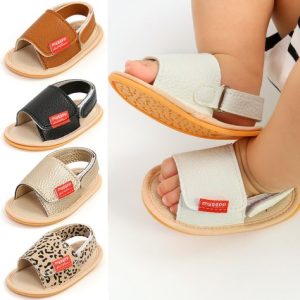
Beyond Shoes
- Barefoot Time: Allow your toddler plenty of barefoot time indoors on safe surfaces. This helps strengthen muscles and improve balance.
- Variety is Key: Alternate between different shoe types to accommodate different activities and weather conditions.
- Pay Attention to Gait: If you notice any concerns about your toddler’s walking pattern, consult with a pediatrician.
By following these tips, you can help your 18-month-old develop strong, healthy feet that will carry them far!
Keeping Tiny Toes Happy and Healthy
Additional Tips for Encouraging Good Foot Health
- Sock It Up: Choose socks made from natural, breathable fibers like cotton. Well-fitting socks help prevent blisters and keep feet comfortable.
- Trim Those Toenails: Regularly trim your toddler’s toenails to prevent ingrown nails and make putting on shoes easier.
The Fun Stuff!
- Shoe Shopping Spree: Make shoe shopping a fun and positive experience for your toddler. Let them choose the color or a fun design within your pre-selected options that prioritize good fit and support.
- Sing a Shoe Song: Create a little song or rhyme about putting on shoes to make it a more enjoyable routine.
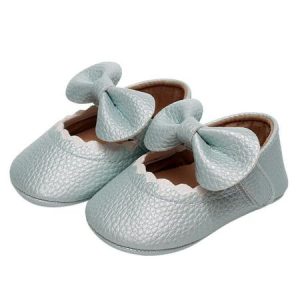
The right shoes can make a big difference in your toddler’s comfort and development. By prioritizing features like good fit, flexibility, and support, you can help your little one explore their world confidently. Remember, healthy feet are happy feet!
Factors to Consider
1. Size and Fit
- Prioritize shoes that provide ample room for growth without being too loose or tight.
- Look for styles with adjustable straps or elastic bands for a snug fit.
2. Support and Stability
- Opt for shoes with sturdy soles and ankle support to help your toddler maintain balance and stability.
- Flexible materials allow for natural foot movement while providing adequate support.
3. Comfort
- Choose lightweight and breathable materials to keep your child’s feet comfortable and cool.
- Avoid shoes with rough seams or tight spots that may cause discomfort or irritation.
4. Durability
- Invest in well-made shoes with reinforced toes and durable construction to withstand the wear and tear of active play.
- Quality materials and craftsmanship ensure longevity and value for money.
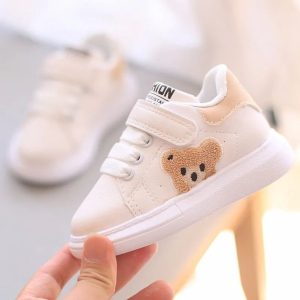
Considerations for Shoe Shopping
What kind of shoes for an 18 month old? When venturing out to purchase shoes for your 18-month-old, keep these key considerations in mind to ensure you find the perfect pair:
1. Measure Their Feet
- Children’s feet grow rapidly, so it’s essential to measure their feet regularly to ensure the shoes fit properly.
- Use a foot-measuring device or visit a shoe store with trained staff to accurately determine your child’s shoe size.
2. Check for Room to Grow
- Aim for a thumb’s width of space between the longest toe and the end of the shoe to accommodate growth.
- Avoid buying shoes that are too large, as they can cause tripping or discomfort.
3. Test the Flexibility
- Bend the shoe in your hands to assess its flexibility. A good shoe should bend easily at the ball of the foot but remain supportive in the heel.
4. Examine the Construction
- Look for shoes with smooth interiors and no rough seams or stitching that could rub against your child’s foot.
- Check for any potential choking hazards, such as small embellishments or loose parts.
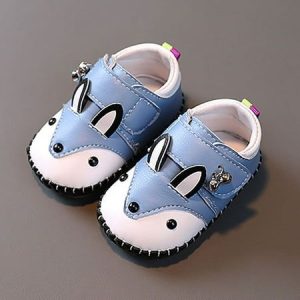
5. Consider Velcro or Elastic Closures
- Velcro or elastic closures make it easier to put on and take off shoes, especially for squirmy toddlers.
- Adjustable closures also ensure a secure and comfortable fit.
6. Prioritize Breathable Materials
- Choose shoes made from breathable materials like leather, canvas, or mesh to prevent sweating and discomfort.
- Avoid plastic or synthetic materials that may trap heat and moisture.
7. Seek Professional Advice
- Don’t hesitate to seek advice from a pediatrician or podiatrist if you have concerns about your child’s foot development or shoe fit.
- Shoe store staff trained in fitting children’s shoes can also provide valuable guidance and assistance.





